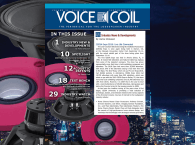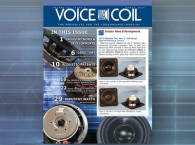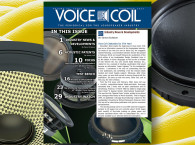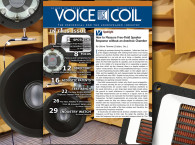 In this edition, Vance Dickason writes about the Audio Precision APx500 Flex Audio Analyzer in Industry News and Developments. But this is no press release. Here, he shares his hands-on experience with this latest APx500 Flex Audio Analyzer, designed to work with third-party USB audio recording interfaces. And to make the experience even more complete and valuable for Voice Coil readers, Dan Knighten, AP's VP of Product Development, and Michael Martin, AP's Product Marketing Manager, brought a complete analyzer to Dickason's place and assisted him in performing a series of R&D type measurements on the same driver featured in this edition's Test Bench column. Which means, readers can compare the readings and results directly!
In this edition, Vance Dickason writes about the Audio Precision APx500 Flex Audio Analyzer in Industry News and Developments. But this is no press release. Here, he shares his hands-on experience with this latest APx500 Flex Audio Analyzer, designed to work with third-party USB audio recording interfaces. And to make the experience even more complete and valuable for Voice Coil readers, Dan Knighten, AP's VP of Product Development, and Michael Martin, AP's Product Marketing Manager, brought a complete analyzer to Dickason's place and assisted him in performing a series of R&D type measurements on the same driver featured in this edition's Test Bench column. Which means, readers can compare the readings and results directly!
Next up, Mike Klasco writes about Recent Developments with Loudspeaker Enclosure Materials. In this new report, Klasco once again shares his knowledge with loudspeaker enclosures and reports on the progress in enclosure materials and technologies in 2020. And if someone has interesting things to share about wood enclosures, composites, plastics, improved plastic-based formulas, ABS/PA (polyimide), thermoset and thermoplastic resins, bulk-molded and sheet-molded thermosets and more, it's certainly Mike Klasco.
After this update for loudspeaker designers, Nora Wong (Menlo Scientific, Ltd.) prepared a valuable Speaker Enclosure Vendor Directory. As Wong notes, the trend has been for speaker enclosure factories to expand "vertically" to complete loudspeaker system assembly, but most still offer cabinets. Some of the most famous manufacturers have evolved into new companies and are highly specialized in this domain. Read on to learn their identities.
This edition also includes a regular Lab Notes contributed article by Christopher J. Struck (CJS Labs) titled "Improved Zobel Network." In this briefing, Struck discusses a dramatic improvement over passive crossover filter networks for multi-way loudspeakers.
And in Acoustic Patents, James Croft (Croft Acoustical), explores a new patent awarded directly to inventor James R. Suhre (North Las Vegas, NV), describing an Orthogonal Open-Back Speaker System. Challenged directly by Dickason who noticed the patent, Croft explores everything there is to know about this interesting document, describing in its simplest form, a loudspeaker system with "one or more drivers having their back side connected to a duct that is open at the top end and closed at the bottom end," with a port aperture "provided at a vertical location in the duct to provide a null at that location," and where "the front wave of the drivers is directed toward the listener and the back wave is directed toward the ceiling, spreading out and down into the room, to be met by the front wave; the opposite phases canceling, eliminating excitation of room resonances and reflections." In summary, the exploration of the patent describes what is "basically a novel form, or more precisely, a novel orientation, of a multi-way, first-order gradient, cardioid structure," as Croft describes.
No doub, this is one of those patents that deserves attention and that might generate other permutations, apart from having a lot in common with many previous designs that the review also details. Read on.
Finally, in this month's Test Bench, Dickason characterizes a home audio transducer from Eastech’s Punktkilde line, more precisely the AUGWL0016-JN02 6.5" midbass driver. This is a new model from the Punktkilde brand that features a unique Magnesium-Lithium (Mg-Li) alloy cone. Mg-Li alloy is the same material used in the Eastech 1" dome tweeter (the AUGDL0003-JN03) featured in Test Bench in the November 2019 issue of Voice Coil. As Dickason notes, this is a very nice looking woofer. Notable features for the 6.5" AUGWL0016-JN02 include a proprietary eight-spoke cast-aluminum frame (basket) that is vented below the spider (damper) mounting shelf, and a lightweight, low density heat resistant Mg-Li alloy flat profile cone with a 2" diameter convex dust cap out of the same material. Compliance is provided by a fairly narrow 9 mm wide NBR (CBR) surround and a 3.5” diameter cloth elevated spider, all driven by a 49.5 mm diameter aluminum voice coil with five 0.25” diameter vents around the peripheral of the voice coil. These five vents are located below the spider mounting shelf. The motor structure consists of a 119 mm diameter, 20 mm thick ferrite ring 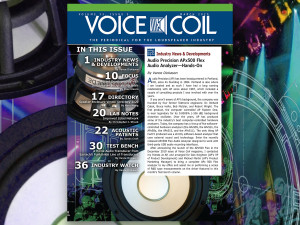 magnet with a milled and polished 6 mm thick front plate and a milled, shaped, and polished T-yoke. Additional cooling is provided by a 20 mm diameter pole vent with a curved outlet to minimize turbulence and a screen to keep out foreign material.
magnet with a milled and polished 6 mm thick front plate and a milled, shaped, and polished T-yoke. Additional cooling is provided by a 20 mm diameter pole vent with a curved outlet to minimize turbulence and a screen to keep out foreign material.
The March 2020 edition of Voice Coil concludes with the traditional Industry Watch section.
Voice Coil March 2020 is available for download and already in the mail for print subscribers. Subscribers can go to - www.gotomyvcoil.com - to download this issue.
Remember, Voice Coil is available in print and download for all registered subscribers, free for industry professionals. To qualify for a free subscription to Voice Coil, or renew your subscription, go to: audioxpress.com/page/Voice-Coil-Subscriber-Services.html

- on Magazine News
- News
From Drivers to Enclosures, Don't Miss Voice Coil March 2020!
February 26 2020, 17:10
The March 2020 edition of Voice Coil is now available online and in print. In this edition, Vance Dickason gets hands-on with the Audio Precision APx500 Flex Audio Analyzer, Mike Klasco writes about Loudspeaker Enclosure Materials, and James Croft explores a new patent of a novel orientation of a cardioid speaker design. And in Test Bench, Dickason characterizes a home audio transducer from Eastech's Punktkilde line, the cosmetically pleasing AUGWL0016-JN02 6.5” midbass driver.


